Reliability and Sensitivity Analysis of Wireless Sensor Network Using a Continuous-Time Markov Process
Abstract
1. Introduction
2. Materials and Methods
2.1. Wireless Sensor Network Description
2.2. Nomanculture
3. Mathematical Modeling Approach of the WSN and Solution
4. Calculation of Various Reliability Indices
4.1. Reliability of the WSN
4.1.1. WSN Reliability with Fluctuation in Sensing Unit Failure
4.1.2. WSN Reliability with Fluctuation in Transceiver Failure
4.1.3. WSN Reliability with Fluctuation in Microcontroller Failure
4.1.4. WSN Reliability with Fluctuation in Power Unit Failure
4.2. Mean Time to Failure (MTTF) Analysis
4.3. Sensitivity Analysis
Sensitivity Analysis for Reliability of the WSN
4.4. Sensitivity Analysis for MTTF of WSN
5. Results Discussion
6. Conclusions
Author Contributions
Funding
Data Availability Statement
Acknowledgments
Conflicts of Interest
References
- Kandris, D.; Nakas, C.; Vomvas, D.; Koulouras, G. Applications of wireless sensor networks: An up-to-date survey. J. Appl. Syst. Innov. 2020, 3, 14. [Google Scholar] [CrossRef]
- Baduge, S.K.; Thilakarathna, S.; Perera, J.S.; Arashpour, M.; Sharafi, P.; Teodosio, B.; Shringi, A.; Mendis, P. Artificial intelligence and smart vision for building and construction 4.0: Machine and deep learning methods and applications. Autom. Constr. 2022, 141, 104440. [Google Scholar] [CrossRef]
- Adu-Manu, K.S.; Abdulai, J.D.; Engmann, F.; Akazue, M.; Appati, J.K.; Baiden, G.E.; Sarfo-Kantanka, G. WSN architectures for environmental monitoring applications. J. Sens. 2022, 1, 7823481. [Google Scholar] [CrossRef]
- Chowdhury, M.Z.; Shahjalal, M.; Ahmed, S.; Jang, Y.M. 6G wireless communication systems: Applications, requirements, technologies, challenges, and research directions. IEEE Open J. Commun. Soc. 2020, 1, 957–975. [Google Scholar] [CrossRef]
- Khalifeh, A.; Mazunga, F.; Nechibvute, A.; Nyambo, B.M. Microcontroller unit-based wireless sensor network nodes: A review. Sensors 2022, 22, 8937. [Google Scholar] [CrossRef] [PubMed]
- Lanzolla, A.; Spadavecchia, M. Wireless sensor networks for environmental monitoring. Sensors 2022, 21, 1172. [Google Scholar] [CrossRef]
- Patel, N.; Rai, R.N.; Patil, H.; Shrivastava, P. Reliability Analysis of Cutting Tools for Industrial Applications: An Integrated AHP-RSM-PHM Approach. Int. J. Math. Eng. Manag. Sci. 2024, 9, 756–778. [Google Scholar] [CrossRef]
- de Vasconcelos, V.; Soares, W.A.; da Costa, A.C.L.; Raso, A.L. Use of Reliability Block Diagram and Fault Tree Techniques in Reliability Analysis of Emergency Diesel Generators of Nuclear Power Plants. Int. J. Math. Eng. Manag. Sci. 2019, 4, 814–823. [Google Scholar] [CrossRef]
- Chachra, A.; Ram, M.; Kumar, A. Fuzzy reliability framework under hesitant and dual hesitant fuzzy sets to air conditioning system. Opsearch 2024, 61, 603–627. [Google Scholar] [CrossRef]
- Arjannikov, T.; Diemert, S.; Ganti, S.; Lampman, C.; Wiebe, E.C. Using markov chains to model sensor network reliability. In Proceedings of the 12th International Conference on Availability, Reliability and Security, New York, NY, USA, 29 August–1 September 2017; pp. 1–10. [Google Scholar]
- Oreku, G.S. Reliability in WSN for security: Mathematical approach. In Proceedings of the 2013 International Conference on Computer Applications Technology (ICCAT), Sousse, Tunisia, 20–22 January 2013; pp. 1–6. [Google Scholar]
- Mishra, P.; Dash, R.K. A novel method for evaluation of reliability of WSN under different failure models. In Proceedings of the 2020 IEEE International Symposium on Sustainable Energy, Signal Processing and Cyber Security (iSSSC), Odisa, India, 16 December 2020; pp. 1–6. [Google Scholar]
- Shrestha, A.; Xing, L.; Liu, H. Modeling and evaluating the reliability of wireless sensor networks. In Proceedings of the 2007 Annual Reliability and Maintainability Symposium, Orlando, FL, USA, 22–25 January 2007; pp. 186–191. [Google Scholar]
- Kabashkin, I.; Kundler, J. Reliability of sensor nodes in wireless sensor networks of cyber physical systems. Procedia Comput. Sci. 2017, 104, 380–384. [Google Scholar] [CrossRef]
- Silva, I.; Guedes, L.A.; Portugal, P.; Vasques, F. Reliability and availability evaluation of wireless sensor networks for industrial applications. Sensors 2012, 12, 806–838. [Google Scholar] [CrossRef] [PubMed]
- Dâmaso, A.; Rosa, N.; Maciel, P. Reliability of wireless sensor networks. Sensors 2014, 14, 15760–15785. [Google Scholar] [CrossRef] [PubMed]
- Catelani, M.; Ciani, L.; Bartolini, A.; Del Rio, C.; Guidi, G.; Patrizi, G. Reliability analysis of wireless sensor network for smart farming applications. Sensors 2021, 21, 7683. [Google Scholar] [CrossRef] [PubMed]
- Jung, S.; Choi, J.P. End-to-end reliability of satellite communication network systems. IEEE Syst. J. 2020, 15, 791–801. [Google Scholar] [CrossRef]
- Joshi, T.; Goyal, N.; Ram, M. An approach to analyze reliability indices in peer-to-peer communication systems. Cybern. Syst. 2022, 53, 716–733. [Google Scholar] [CrossRef]
- Ram, M.; Tyagi, V.; Rawat, N. Reliability modelling and sensitivity analysis of IOT based flood alerting system. J. Qual. Maint. Eng. 2021, 27, 292–307. [Google Scholar]
- Singh, V.V.; Poonia, P.K.; Rawal, D.K. Reliability analysis of repairable network system of three computer labs connected with a server under 2-out-of-3 G configuration. Life Cycle Reliab. Saf. Eng. 2021, 10, 19–29. [Google Scholar] [CrossRef]
- Kumar, A.; Kumar, P. Application of markov process/mathematical modelling in analysing communication system reliability. Int. J. Qual. Reliab. Manag. 2020, 37, 354–371. [Google Scholar] [CrossRef]
- Bisht, S.; Kumar, A.; Goyal, N.; Ram, M.; Klochkov, Y. Analysis of network reliability characteristics and importance of components in a communication network. Mathematics 2021, 9, 1347. [Google Scholar] [CrossRef]
- Shunqi, Y.; Ying, Z.; Xiang, L.; Yanfeng, L.; Hongzhong, H. Reliability analysis for wireless communication networks via dynamic Bayesian network. J. Syst. Eng. Electron. 2023, 34, 1368–1374. [Google Scholar] [CrossRef]
- Poonia, P.K. Performance assessment and sensitivity analysis of a computer lab network through copula repair with catastrophic failure. J. Reliab. Stat. Stud. 2022, 15, 105–128. [Google Scholar] [CrossRef]
- Xing, L. Reliability in Internet of Things: Current status and future perspectives. IEEE Internet Things J. 2020, 7, 6704–6721. [Google Scholar] [CrossRef]
- Kumar, P.; Kumar, A. Quantifying reliability indices of garbage data collection iot-based sensor systems using markov birth-death process. Int. J. Math. Eng. Manag. Sci. 2023, 8, 1255–1274. [Google Scholar] [CrossRef]
- Xing, L.; Zhao, G.; Xiang, Y.; Liu, Q. A behavior-driven reliability modeling method for complex smart systems. Qual. Reliab. Eng. Int. 2021, 37, 2065–2084. [Google Scholar] [CrossRef]
- Choudhary, S.; Ram, M.; Goyal, N.; Saini, S. Reliability Analysis of Mobile Communication System using Markov Process. In Proceedings of the 2022 2nd International Conference on Innovative Sustainable Computational Technologies (CISCT), Dehradun, India, 23–24 December 2022; pp. 1–5. [Google Scholar]
- Wang, C.; Xing, L.; Vokkarane, V.M.; Sun, Y. Infrastructure communication sensitivity analysis of wireless sensor networks. Qual. Reliab. Eng. Int. 2016, 32, 581–594. [Google Scholar] [CrossRef]
- Chakraborty, S.; Goyal, N.K.; Mahapatra, S.; Soh, S. Monte-Carlo Markov chain approach for coverage-area reliability of mobile wireless sensor networks with multistate nodes. Reliab. Eng. Syst. Saf. 2020, 193, 106662. [Google Scholar] [CrossRef]
- Gupta, N.; Saini, M.; Kumar, A. Operational availability analysis of generators in steam turbine power plants. SN Appl. Sci. 2020, 2, 779. [Google Scholar] [CrossRef]
- Kijima, M. Markov Processes for Stochastic Modeling; Springer: New York, NY, USA, 2013; pp. 1–23. [Google Scholar]
- Lbe, O. Fundamentals of Applied Probability and Random Processes, 2nd ed.; Academic Press: Cambridge, MA, USA, 2014; pp. 358–376. [Google Scholar]


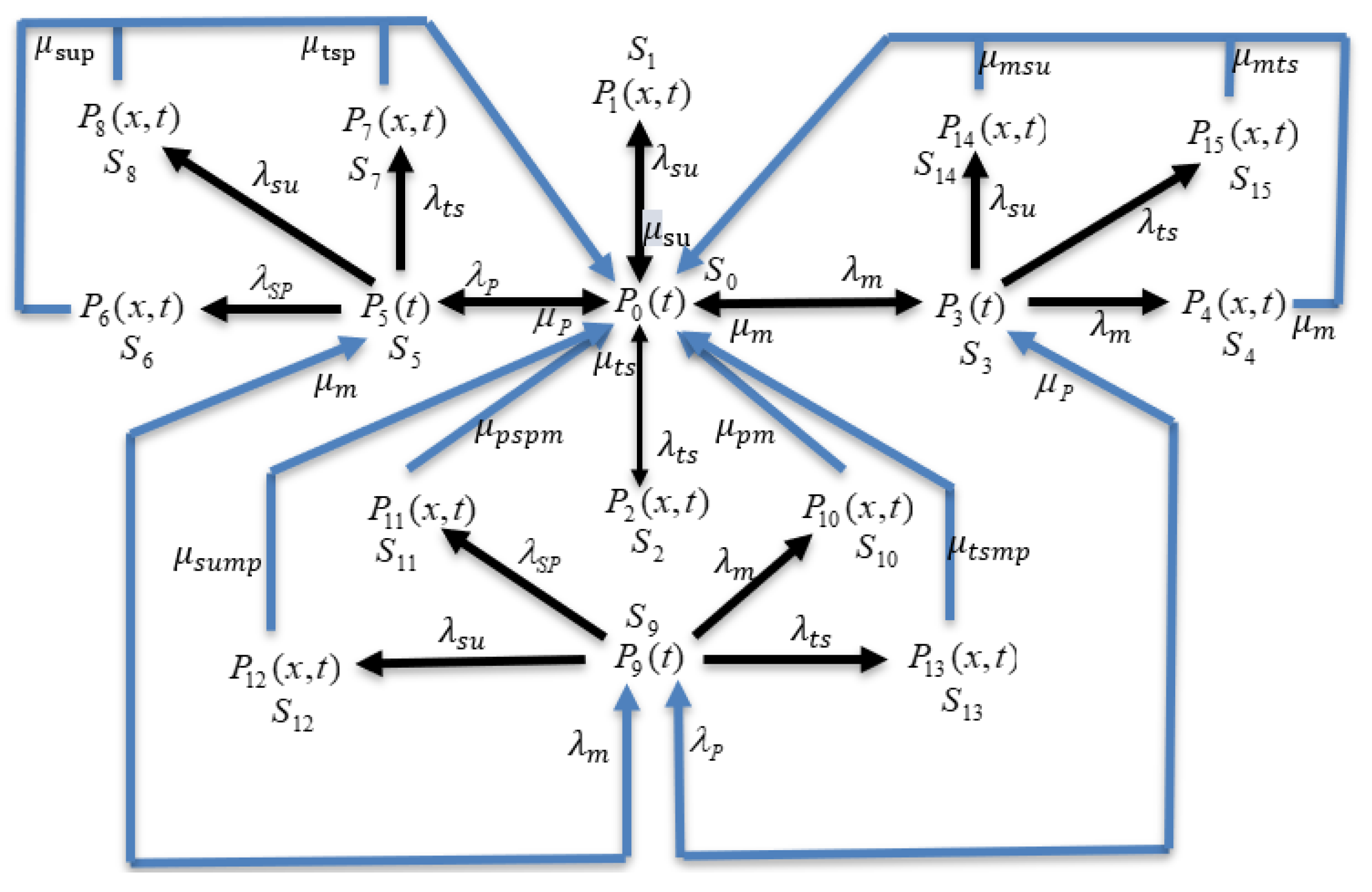
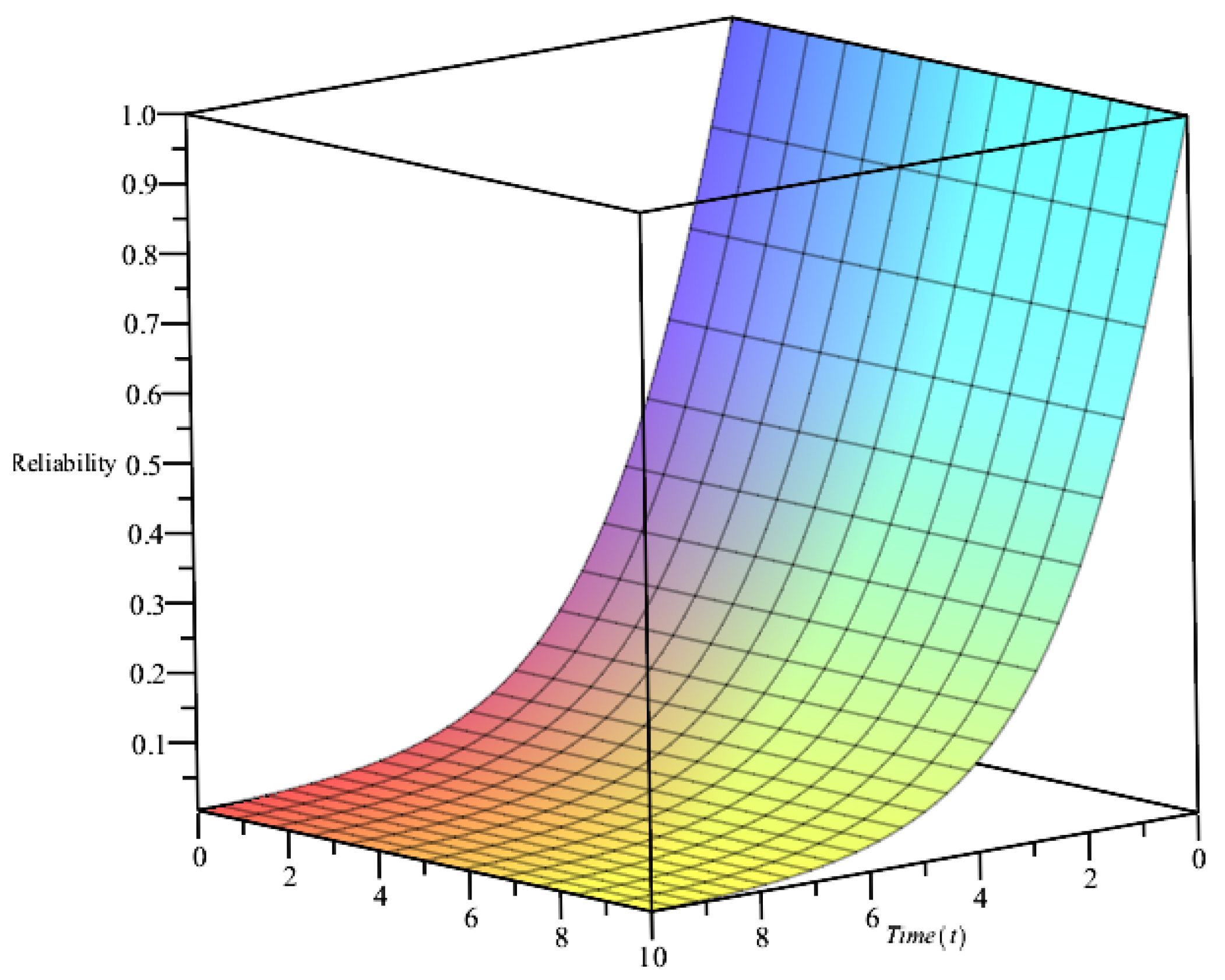
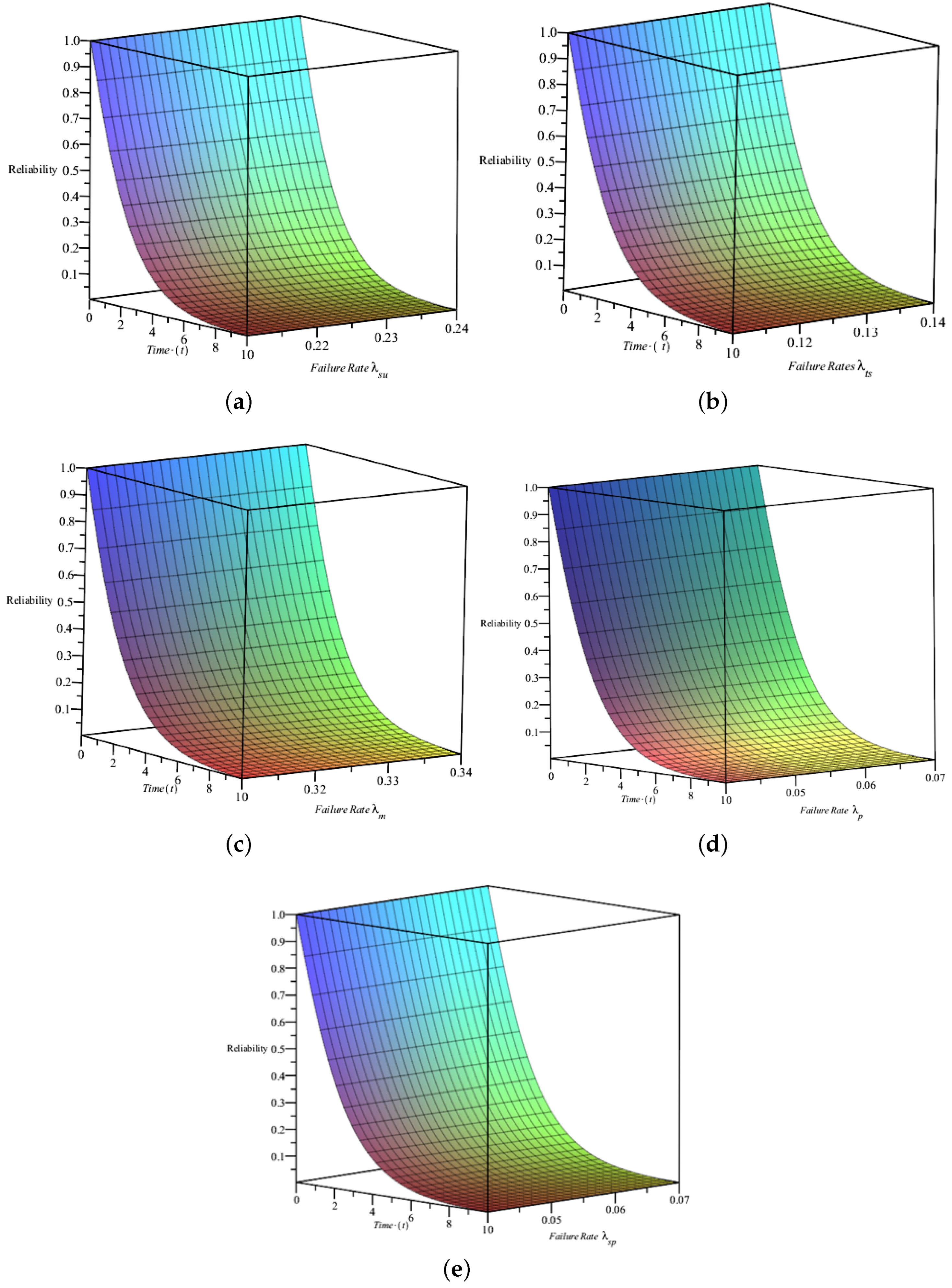
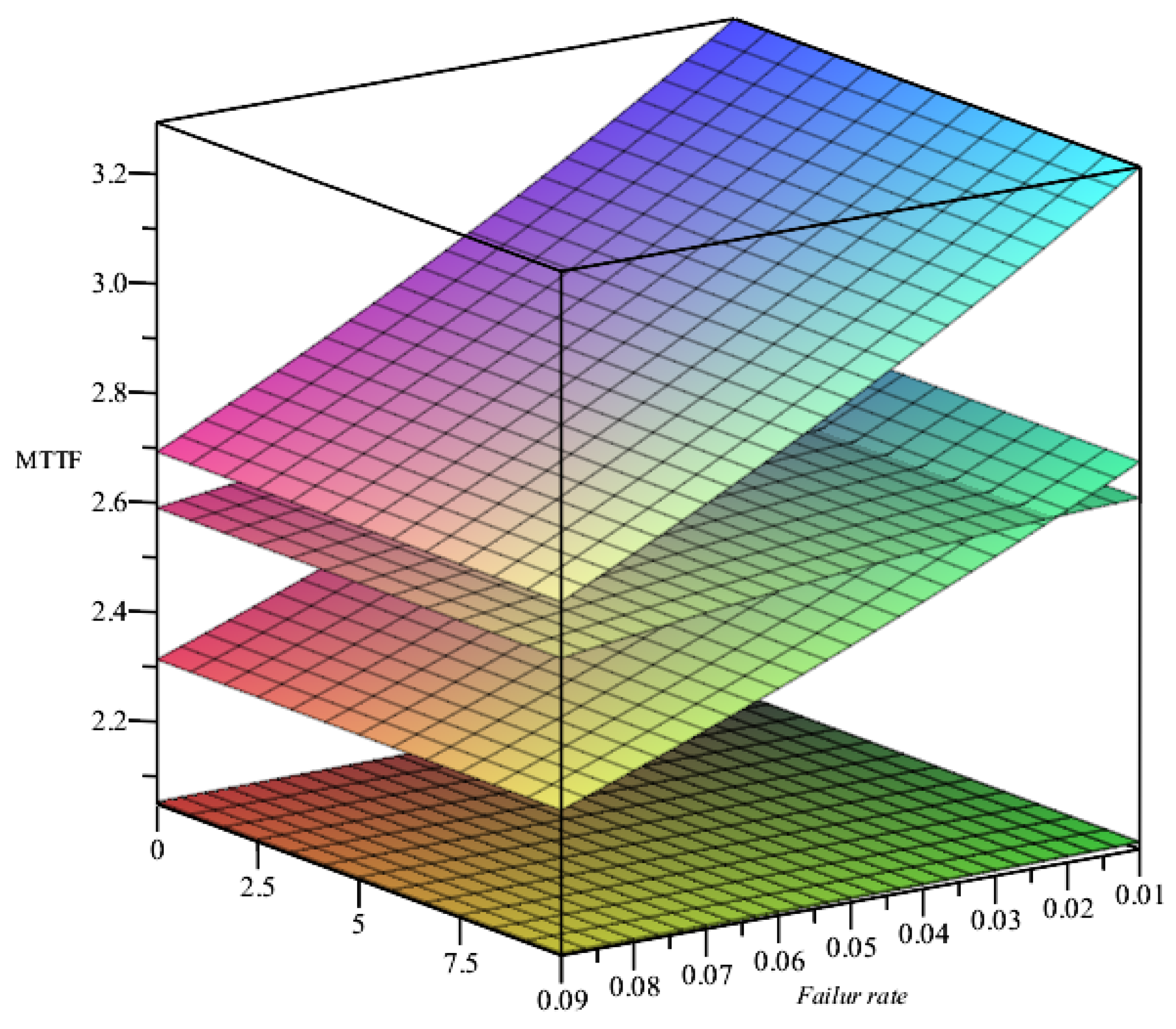
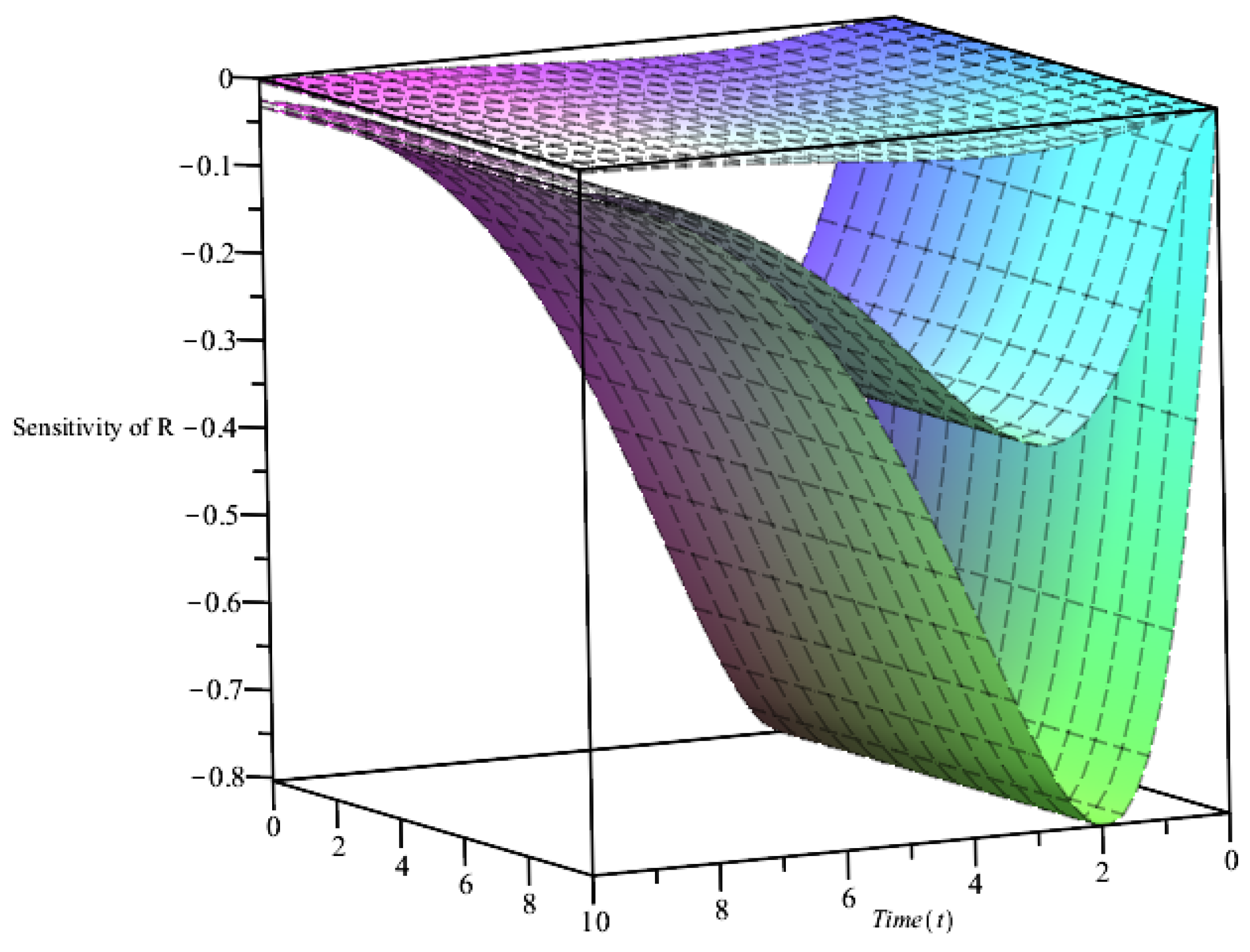
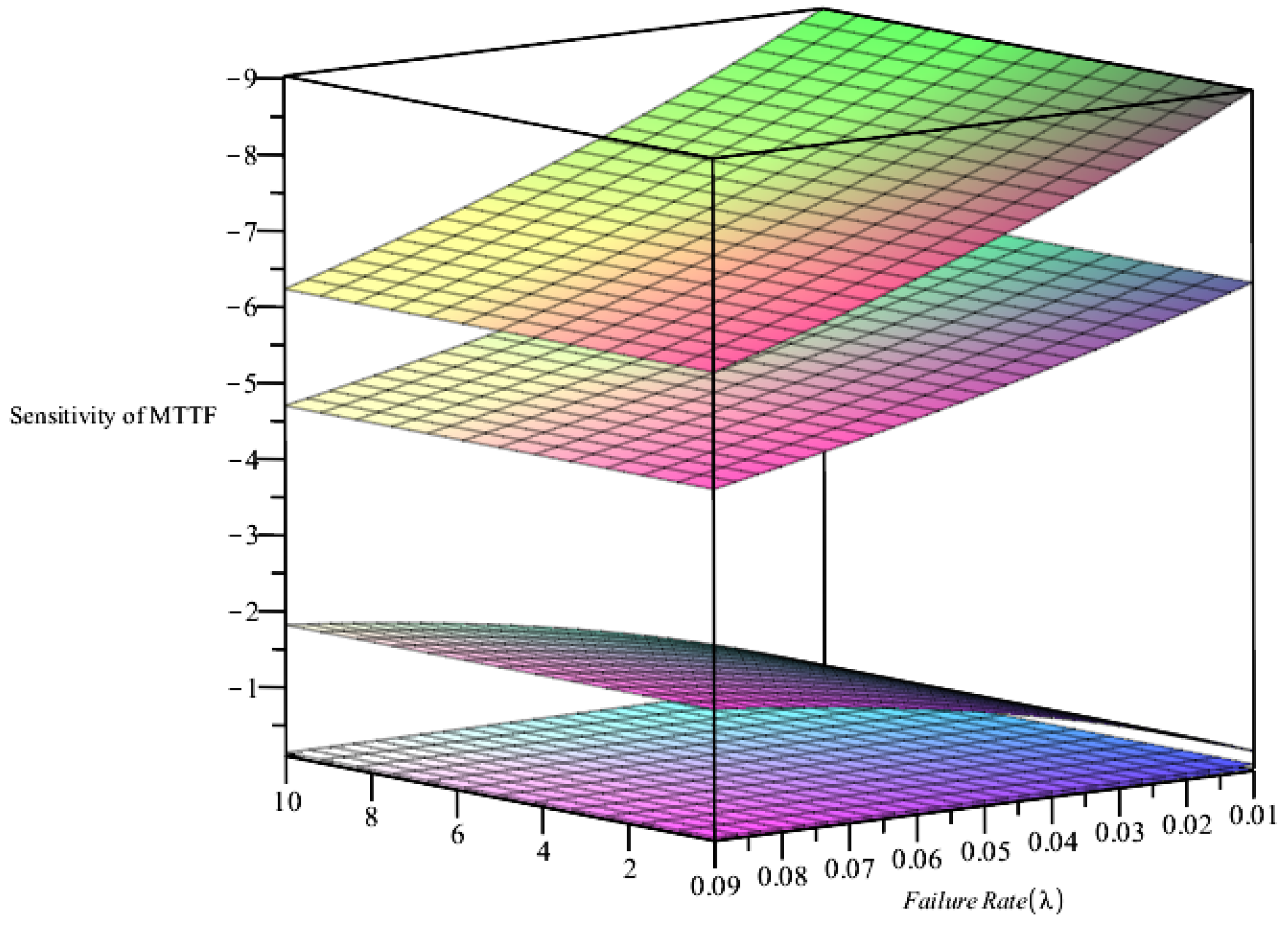
| Notation | Description |
|---|---|
| Time variable/frequency variable | |
| (t) | Probability of the system being in the ith state |
| (t) | Represents Laplace transformation of (t) |
| (x,t) | Probability of the failed system being in the ith state |
| (x,s) | Represents Laplace transformation of (x,t) |
| //// | Represents the failure rate of the sensing unit/transceiver/microcontroller/power supply/standby power supply |
| //// | Represents the repair rate of the sensing unit/transceiver/microcontroller/power supply/standby power supply |
| // | Represents repair rate of the power supply and microcontroller/microcontroller and sensing unit/microcontroller and transreceiver |
| / / | Represents simultaneous repair rate of the trans receiver and power supply/power supply and standby power supply/sensing unit and power supply |
| // | Represents repair rate of power supply, standby power supply, and microcontroller/sensing unit, microcontroller, and power supply/transreceiver, microcontroller, and power supply |
| State Probability | Description |
|---|---|
| (t) | Represents the good state of the system i.e., a state in which and all the components of the WSN are in good working condition |
| (x,t) | Represents the failed state of the system due to the failure of the sensing unit |
| (x,t) | Represents the failed state of the system due to the failure of the trans receiver |
| (t) | Represents the degraded state of the system due to the failure of the one microcontroller |
| (x,t) | Represents the failed state of the system due to the failure of the both microcontrollers |
| (t) | Represents that the system is in a degraded state due to the failure of the main power supply |
| (x,t) | Represents the failed state of the system due to the failure of both the main power supply and standby power supply |
| (x,t) | Represents the failed state of the system due to the failure of the trans receiver after the failure of the main power supply |
| (x,t) | Represents the failed state of the system due to the failure of the sensing unit after the failure of the main power supply |
| (t) | Represents the degraded state of the system after the failure of the main power supply and one microcontroller |
| (x,t) | Represents the failed state of the system due to the failure of both the microcontroller and main power supply |
| (x,t) | Represents the failed state of the system due to the failure of the main power supply, standby power supply, and microcontroller |
| (x,t) | Represents the failed state of the system due to the failure of the sensing unit after the failure of the one microcontroller and main power supply |
| (x,t) | Represents the failed state of the system due to the failure of the trans receiver after the failure of the one microcontroller and main power supply |
| (x,t) | Represents the failed state of the system due to the failure of one microcontroller and sensing unit |
| (x,t) | Represents the failed state of the system due to the failure of one microcontroller and trans receiver |
| Failure Rate | |||||
|---|---|---|---|---|---|
| 0.01 | 3.29411 | 2.75676 | 2.69047 | 2.06279 | 2.06219 |
| 0.02 | 3.20597 | 2.69303 | 2.68534 | 2.06158 | 2.0604 |
| 0.03 | 3.12205 | 2.63197 | 2.6774 | 2.0604 | 2.05867 |
| 0.04 | 3.04208 | 2.57342 | 2.66707 | 2.05926 | 2.05699 |
| 0.05 | 2.96579 | 2.51725 | 2.6547 | 2.05816 | 2.05536 |
| 0.06 | 2.89295 | 2.46331 | 2.64062 | 2.05709 | 2.05378 |
| 0.07 | 2.82334 | 2.41148 | 2.62509 | 2.05605 | 2.05225 |
| 0.08 | 2.75676 | 2.36165 | 2.60833 | 2.05505 | 2.05076 |
| 0.09 | 2.69303 | 2.3137 | 2.59055 | 2.05407 | 2.04932 |
Disclaimer/Publisher’s Note: The statements, opinions and data contained in all publications are solely those of the individual author(s) and contributor(s) and not of MDPI and/or the editor(s). MDPI and/or the editor(s) disclaim responsibility for any injury to people or property resulting from any ideas, methods, instructions or products referred to in the content. |
© 2024 by the authors. Licensee MDPI, Basel, Switzerland. This article is an open access article distributed under the terms and conditions of the Creative Commons Attribution (CC BY) license (https://creativecommons.org/licenses/by/4.0/).
Share and Cite
Kumar, A.; Jadhav, S.; Alsalami, O.M. Reliability and Sensitivity Analysis of Wireless Sensor Network Using a Continuous-Time Markov Process. Mathematics 2024, 12, 3057. https://doi.org/10.3390/math12193057
Kumar A, Jadhav S, Alsalami OM. Reliability and Sensitivity Analysis of Wireless Sensor Network Using a Continuous-Time Markov Process. Mathematics. 2024; 12(19):3057. https://doi.org/10.3390/math12193057
Chicago/Turabian StyleKumar, Amit, Sujata Jadhav, and Omar Mutab Alsalami. 2024. "Reliability and Sensitivity Analysis of Wireless Sensor Network Using a Continuous-Time Markov Process" Mathematics 12, no. 19: 3057. https://doi.org/10.3390/math12193057
APA StyleKumar, A., Jadhav, S., & Alsalami, O. M. (2024). Reliability and Sensitivity Analysis of Wireless Sensor Network Using a Continuous-Time Markov Process. Mathematics, 12(19), 3057. https://doi.org/10.3390/math12193057





